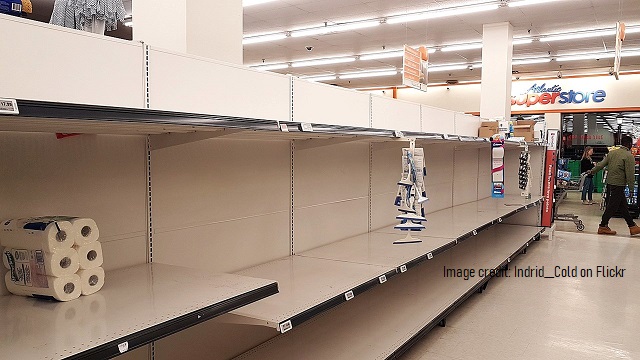Why Are There Toilet Paper Shortages around the World?

There are a few explanations for the run on toilet paper, but one basic economic lesson explains the shortage.
Americans have seen scarcity, bailouts, price fluctuations, and epidemics before, but one thing seems to set the coronavirus emergency apart:
The toilet paper.
Shelves where the product once was stored are bare—and not just in the US. The United Kingdom has experienced similar shortages, leading consumers to purchase toilet paper substitutes (at the risk of the sewage system), and an Australian newspaper went so far as to print eight blank pages in a recent issue to be used in case of emergency for, you guessed it, toilet paper.
The desire to hoard during a pandemic may be totally natural, but hoarding for some means scarcity for others.
What is a good solution for this problem? Many stores have instigated their own rationing devices (limits of X amount of toilet paper, hand sanitizers, etc., per customer), with others instituting hours of shopping reserved for the elderly or immunocompromised.
These are creative and compassionate ideas, and they may solve some of the problem of hoarding—but the market has another way.
The problem? It’s incredibly unpopular, and, of course, even illegal in many places.
Understanding the Price Gouging Problem
“Price gouging” has a particularly negative connotation. It refers to a phenomenon wherein customers at an especially vulnerable time are charged unusually high prices by “greedy” business owners taking advantage of their need.
But think about the incentives of business owners—do you know a single entrepreneur, business owner, or honest employee who wants to intentionally upset their customers? The incentive of business owners is always to provide great service and reasonable prices. To act otherwise is to eventually run out of business.
These incentives do not suddenly change during a crisis—business owners are still judged by the court of public opinion, and those who treat customers unfairly will not go unnoticed, at least not for long.
So why do prices rise during times of need? The answer is found in the basic economic principles of supply and demand.
When demand increases, it’s a signal that customers want to consume more of a certain product.
Basic Economics: Supply and Demand
The graph below demonstrates these changes. The demand line shifts up from D1 to D2—increasing prices, but only temporarily. Prices are a rationing device and signal of scarcity, so this higher price naturally encourages customers to make do with less while simultaneously indicating to producers to expand production.
Though buyers have to pay more for each product, it reduces the risk of shortages by making it easier for suppliers to meet the increased demand for their goods. [See chart]
What’s perhaps more relevant to our current situation is that hoarders are indirectly discouraged from hoarding. A higher price makes consumers think twice before buying a cart-full of toilet paper, leaving more product on the shelves and limiting or delaying, perhaps indefinitely, any shortage.
But that’s not all, remember that the higher price is only temporary, since higher prices will spur production.
Sellers see product flying off the shelves and note that they need to ramp up production to meet the growing demand. Potential entrepreneurs also recognize that there may be room for extra business in this particular market, so they start production.
Once supply is able to catch up, the supply line shifts from S1 to S2, and prices normalize once again. [See chart 1 and chart 2]
Sure these are merely graphs, and it is difficult to appropriately convey the nuances of human behavior and the complexity of the economy in a single graph.
However, we’ve already seen these forces at work in the past few weeks. Distilleries have taken note of hand sanitizer shortages and are helping to meet the increased demand by producing their own—some even giving their product away for free. Last week Georgia-Pacific, a toilet paper supplier, increased production capacity by 120 percent.
Amplified production by existing companies, and the entrance of new business into markets, will lower prices to pre-crisis levels.
Referring to rising prices as “price gouging” will not change the economic fact: in a free economy, prices are a vital signal to producers and consumers alike. It’s incredible that a single number can do so much.
This is the miracle inherent in free markets—no solitary, all-knowing authority is dictating the direction of prices or production in a single market (let alone an entire economy). It happens naturally, as if led by an invisible hand.
The Toilet Paper Shortage
So why was there a sudden run on toilet paper? Who knows.
Perhaps in anticipation of long periods of quarantine, shoppers are looking for any necessary household goods to stockpile. One consumer psychologist explained that it could simply be retail therapy; stressed consumers rushing for feelings of security during a pandemic. Others simply blame herd mentality—the idea that if everyone else is hoarding toilet paper, you might as well be too.
The ultimate lesson? Let prices rise and markets do their work. As long as economic freedom exists, ingenuity and innovation will never be in short supply—and neither will toilet paper.
COLUMN BY
Amanda Snell
Amanda Snell is an analytics associate at FEE. She grew up in small-town Idaho and is a recent graduate of BYU-Idaho in Economics. Prior to joining FEE, she completed the Charles Koch Internship Program and interned with The Heritage Foundation’s 2019 Index of Economic Freedom. She enjoys working with entrepreneurs and is passionate about the potential for innovation in the private sector. Amanda was deeply impacted by FEE and the freedom philosophy as a high school student and is thrilled to be part of an organization committed to individual liberty and economic freedom.
RELATED ARTICLE: Flexibility Is Needed for Economies to Cope With COVID-19, Not $2,000 Checks
EDITORS NOTE: This FEE column is republished with permission. © All rights reserved.


Leave a Reply
Want to join the discussion?Feel free to contribute!